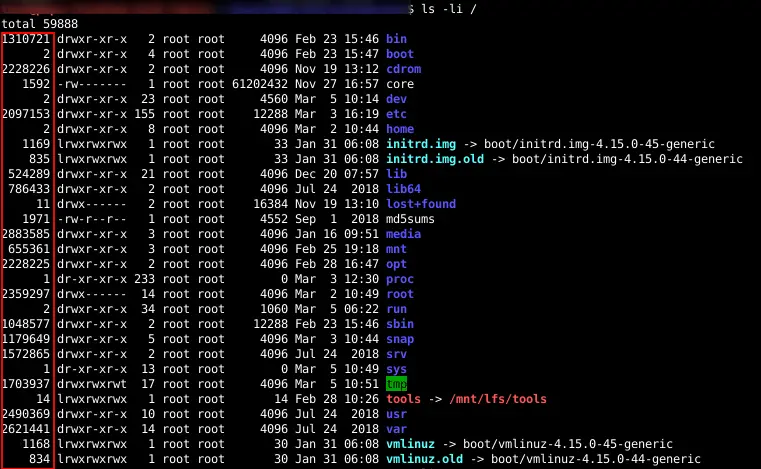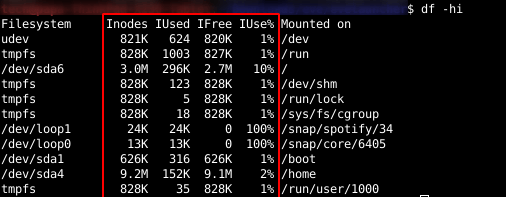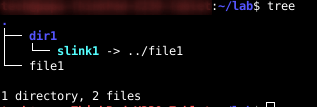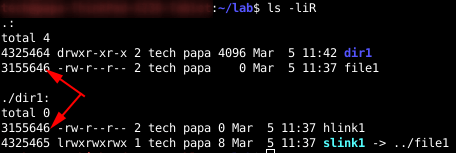- Everything You Need to Know About inodes in Linux
- inodes in brief
- What is inode in Linux?
- How to check inode in Linux?
- How does inode work?
- Inodes & Soft/Hard link
- Other implications of inodes
- What is Inode number in Linux?
- What is inode number in Linux
- Why do we need inodes?
- Check Inodes on a Filesystem
- Find Inode number of File
- Inode Changes with Copy, Move, and Delete
- What to do in case you run out of Inode numbers?
- Wrapping up
Everything You Need to Know About inodes in Linux
What is inode in Linux? What is it used for? Why is it important and how to check inode in Linux? This guide explains all the important aspects of inodes.
I have a strange question for you.
Has your Linux system ever complained that you had no space left while you clearly still have more than enough?
It happened to me, that I had many GB left, but my Linux system complained that no space was left. This is when I learned about inodes.
inodes in brief
Inodes stores metadata for every file on your system in a table-like structure usually located near the beginning of a partition. They store all the information except the file name and the data.
Every file in a given directory is an entry with the filename and inode number. All other information about the file is retrieved from the inode table by referencing the inode number.
Inodes numbers are unique at the partition level. Every partition has its own inode table.
If you run out of inodes, you cannot create new files even if you have space left on the given partition.
What is inode in Linux?
Inode stands for Index Node. Although history is not quite sure about that, it is the most logical and best guess they came up with. It used to be written I-node, but the hyphen got lost over time.
An inode is a data structure … … that stores all the information about a file except its name and its actual data.
Inodes stores metadata about the file it refers to. This metadata contains all the information about the said file.
- Size
- Permission
- Owner/Group
- Location of the hard drive
- Date/time
- Other information
Every used inode refers to 1 file. Every file has 1 inode. Directories, character files, and block devices are all files. They each have 1 inode.
For each file in a directory, there is an entry containing the filename and the inode number associated with it.
Inodes are unique at the partition level. You can have two files with the same inode number given they are on different partitions. Inodes information is stored in a table-like structure in the strategic parts of each partition, often found near the beginning.
How to check inode in Linux?
You can easily list the inodes number with the following command:
The following pictures show my root directory with corresponding inode numbers.
The amount of inodes each file system has is decided when you create the filesystem. For most users, the default number of inodes is more than sufficient.
The default setting when creating a filesystem will create 1 inode per 2K bytes of space. This gives plenty of inodes for most systems. You will more than likely run out of space before you run out of inodes. If need be, you can specify how many inodes to create when creating a file system.
If you run out of inodes, you will be unable to create new files. Your system will also be unable to do so. This is not a situation most users will encounter but it is possible.
For example, a mail server will store a huge amount of very small files. Lots of those files will be below 2K bytes. It is also expected to grow constantly. Therefore a mail server is at risk of running out of inodes way before running out of space.
Some file systems like Btrfs, JFS, XFS have implemented dynamic inodes. They can increase the number of inodes available if needed.
How does inode work?
When a new file is created, it is assigned an inode number and a file name. An inode number is a unique number within that file system. Both name and inode number are stored as entries in a directory.
When I ran the ls command “ls -li /” the file name and inodes number are what was stored in the directory /. The remaining information user, group, file permissions, size, etc was retrieved from the inode table using the inode number.
You can list inode information for each file system with the df command in Linux:
Inodes & Soft/Hard link
A soft link or symbolic link is a well-known feature of Linux. But what happens with Inodes when you create a symbolic link in Linux? In the next picture I have a directory called “dir1“, a file named “file1” and inside “dir1” I have a soft link called “slink1” which points to “../file1“
Now I can list recursively and show the inode information.
As expected, dir1 and file1 have different inode numbers. But so does the soft link. When you create a soft link, you create a new file. In its metadata, it points to the target. For every soft link you create, you use one inode.
After creating a hard link in dir1 with the ln command:
Listing of inodes number gives me the following information:
You can see that “file1″ and “hlink1” have the same inode number. Truthfully, hard links are possible because of inodes. A hard link does not create a new file. It only provides a new name for the same data.
In older versions of Linux, it was possible to hard link a directory. It was even possible to have a given directory be its own parent. This was made possible because of inode implementation. This is now restricted to prevent users from creating a very confusing structure of directories.
Other implications of inodes
The way inodes work is also why it is impossible to create a hard link across the different file systems. Allowing such a task would open the possibility of having conflicting inode numbers. A soft link on the other hand can be created across the different file systems.
Because a hard link has the same inode number as the original file, you can delete the original file and the data is still available through the hard link. All you did, in this case, is remove one of the names pointing to this inode number. The data linked to this inode number will remain available until all names associated with it are deleted.
Inodes are also a big reason why a Linux system can update without the need to reboot. This is because one process can use a library file while another process replaces that file with a new version. Therefore, creating a new inode for the new file. The already running process will keep using the old file while every new call to it will result in using the new version.
Another interesting feature that comes with inodes is the ability to store the data in the inode itself. This is called Inlining. This storing method has the advantage of saving space because no data block will be needed. It also increases the lookup time by avoiding more disk access to get the data.
Some file system like ext4 has an option called inline_data. When enabled, it allows the operating system to store data this way. Due to size limitations, inlining only works for very small files. Ext2 and later will often store soft link information this way. That is if the size is no more than 60 Bytes.
Inodes are not something you interact directly with, but they play an important role. If a partition is to contain many very small files, like a mail server, knowing what they are and how they work can save you a lot of problems down the road.
I hope you liked this article and learned something new and important about inode in Linux. Subscribe to our website to learn more Linux-related information.
What is Inode number in Linux?
Data blocks and inodes are the two elements of a file system in Linux. Once the file is created, you cannot change the number of blocks. Inodes are allocated to files written in Linux filesystems. The filesystem’s database employs these unique Identification numbers to keep track of the files. They handle a file’s information and are critical components of Linux architecture. In this article, we will study inode numbers in detail.
What is inode number in Linux
In Linux, whenever a new file is created, it is given a file name and an inode number. This number works as the unique identifier for that file. As a user, you will use the file name to access the file but Linux will first map that filename with an Inode number in a database to access the file.
In basic words, an Inode number is just like an index number of a book. You may quickly locate the chapters you wish to read by browsing the index page. You won’t be able to discover the proper information without an index page, and you’ll have to go through the entire book to find a certain subject, which is a complete waste of time. The same applies to inodes in Linux. An inode is a data structure that points refer to the individual blocks, making the file. All of the administrative data required to read a file is included in the inode. The metadata for each file is kept in inodes in a table structure and this data includes:
- File types ( executable, block special etc )
- Permissions ( read, write etc )
- UID ( Owner )
- GID ( Group )
- FileSize
- Time stamps including last access, last modification and last inode number change.
- File deletion time
- Number of links ( soft/hard )
- Location of ile on harddisk.
- Some other metadata about file.
One thing to keep in mind is that except for the file name and the actual contents, they hold all of the information connected with a file. Inodes are located at the start of the partition. When you refer to a file by name, the system searches for the appropriate inode in the directory entry file where it resides. This provides your system with the necessary information and file data to run any operation.
Why do we need inodes?
Data is saved on your hard drive in fixed-size blocks. If you save a file that is larger than a normal block, your computer will look for the next available segment to save the remainder of the file. That may become difficult and confusing over time. And inodes can help you here.
While they do not store any of the file’s actual data, they do save its metadata, which includes all of the storage blocks where the file’s contents may be located. Filenames have no effect on inodes. That means you may duplicate a file, rename it, and it will still refer to the same original inode.
Check Inodes on a Filesystem
You can find a total number of inodes on disk by using ‘-i‘ option with df command.
Output:Filesystem Inodes IUsed IFree IUse% Mounted on /dev/sda1 1536000 138846 1397154 10% /
The above command shows the total number of Inodes on /dev/sda1 file system. Also provides the details about used and free inodes.
Each filesystem must-have free inodes available to create a new file. If the inodes are full, the system will not allow you to create a new file.
Find Inode number of File
You can find the inode number of any file using -i command line parameter with the ls command.
The first field in output is an inode number of the file.
Output:1150561 -rw-r--r-- 1 root root 0 Mar 10 01:06 myfile.txt
You can also search file with an inode number using find command. For example:
find /home/rahul -inum 1150561 Output:/home/rahul/myfile.txt
Inode Changes with Copy, Move, and Delete
What happens with the inode number when you copy, move or delete a file on the filesystem.
- Copy file: cp allocates a free inode number and create a new entry into the inode table.
### Check inode of existing file ls -il myfile.txt1150561 -rw-r--r-- 1 root root 0 Mar 10 01:06 myfile.txt### Copy file with new name cp myfile.txt myfile_new.txt### Check inode number of new file. Its changed ls -il myfile_new.txt1150562 -rw-r--r-- 1 root root 0 Mar 10 01:09 myfile_new.txt
### Check inode of existing file ls -il myfile.txt1150561 -rw-r--r-- 1 root root 0 Mar 10 01:06 myfile.txt### Moved file to another directory mv myfile.txt /opt/### Check inode number of moved file. No change in inode ls -il /opt/myfile.txt1150561 -rw-r--r-- 1 root root 0 Mar 10 01:06 /opt/myfile.txt
What to do in case you run out of Inode numbers?
Sometimes, your system may run out of inode numbers, and you may encounter difficulties like no space to write new data, frequent restart, data loss, application freeze, and not being able to log in to the system. In this case, it is recommended to delete the unused files.
Wrapping up
In this article, we learned about inode numbers in Linux and also performed different operations on inodes.




